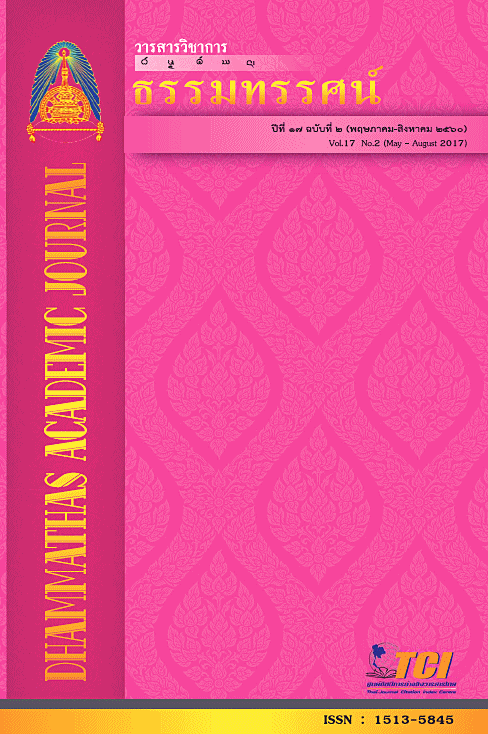การศึกษากลยุทธ์การพัฒนาวัดการจัดการสาธารณูปการในจังหวัดพะเยา
Main Article Content
Abstract
บทคัดย่อ
การศึกษาวิจัยครั้งนี้ มีวัตถุประสงค์ ๓ ประการ คือ ๑) เพื่อศึกษากลยุทธ์การพัฒนาวัด การจัดการสาธารณูปการในจังหวัดพะเยา ๒) เพื่อศึกษาการมีส่วนร่วม การคิด การวางแผนของคณะสงฆ์ หน่วยงานภาครัฐและชุมชนในการพัฒนาวัด การจัดการสาธารณูปการในจังหวัดพะเยา ๓) เพื่อศึกษาปัญหาอุปสรรคแนวทางการพัฒนาการบริหารจัดการ ด้านสาธารณูปการของพระสังฆาธิการในจังหวัดพะเยางานวิจัยฉบับนี้เป็นงานวิจัยเชิงเอกสาร (Documentary Research) และงานวิจัยเชิงคุณภาพ (Qualitative Research) สำรวจเก็บข้อมูลแบบสัมภาษณ์เชิงลึก (In-depth Interview) และสนทนากลุ่ม (Focus Group Discussion) ข้อมูลได้จากหนังสือ เอกสารทางวิชาการ ตลอดถึงงานวิจัยที่เกี่ยวข้องด้วยการสัมภาษณ์แบบมีโครงสร้างแบบเจาะลึก การวิจัยครั้งนี้ ผู้วิจัยกำหนดเก็บข้อมูลกับกลุ่มตัวอย่าง ได้แก่ วัด ๕ แห่ง พระสังฆาธิการ ๑๐ รูป สำนักงานพระพุทธศาสนา ๓ คน สำนักงานวัฒนธรรม ๓ คน ประชาชน ๑๐ คน วิเคราะห์ข้อมูลสรุปประมวลเขียนเชิงพรรณนา
ผลการวิจัยพบว่า
๑. กลยุทธ์การพัฒนาวัด การจัดการสาธารณูปโภคในจังหวัดพะเยา ทั้ง ๕ แห่ง มีกลยุทธ์ใหญ่ ๔ ข้อ ได้แก่ การพัฒนาศาสนสถาน การพัฒนาวัดให้เป็นแหล่งเรียนรู้ การอนุรักษ์วัฒนธรรมประเพณีและการส่งเสริมการมีส่วนร่วม
๒. การมีส่วนร่วมของคณะสงฆ์ หน่วยงานภาครัฐและชุมชนในการพัฒนาวัด มีการประชุมคณะสงฆ์ในจังหวัด แนะนำชี้แจงการก่อสร้างเสนาสนะในวัด โดยเน้นให้อนุรักษ์รูปแบบล้านนาไทยพระสงฆ์ต้องเป็นนักพัฒนา นักอนุรักษ์วางผังวัดให้เป็นสัดส่วนให้ชุมชนเข้ามามีส่วนร่วมพัฒนาอนุรักษ์โดยประชุมอบรมกรรมการวัด ครูสอนศูนย์ศึกษาพระพุทธศาสนาวันอาทิตย์
๓. ปัญหาอุปสรรคและแนวทางการพัฒนาบริหารจัดการด้านสาธารณูปการ ได้แก่ ๑) ด้านก่อสร้างและบูรณปฏิสังขรณ์เสนาสนะวัด ปัญหาที่พบคือ ขาดการดูแลเอาใจใส่ จึงจำเป็นต้องมีการ ตั้งคณะกรรมการควบคุมดูแล ให้มีผู้รับผิดชอบที่เป็นรูปธรรมและเอาใจใส่จริงๆ ๒) ด้านการพัฒนาวัด ปัญหาที่พบคือ งบประมาณก่อสร้างไม่เพียงพอ จึงต้องมีการจัดหางบประมาณก่อนที่จะสร้าง ๓) ด้านการดูแลรักษาและจัดการศาสนสมบัติของวัด ปัญหาที่พบคือ ดำเนินการให้ความรู้เกี่ยวกับการจัดศาสนสมบัติของวัดยังไม่เป็นระบบแก่พระภิกษุสามเณร ๔) การมีส่วนร่วมของพระสังฆาธิการหน่วยงานภาครัฐประชาชนปัญหาที่พบคือ มีความสนใจมาก ผลการศึกษาพบปัญหาและอุปสรรคของการพัฒนาวัดการ
จัดการสาธารณูปการในจังหวัดพะเยา สามารถสรุปได้เป็น ๘ ประการ คือ ๑) ปัญหาด้านงบประมาณ ๒) ปัญหาด้านการก่อสร้าง ๓) ปัญหาด้านการอนุรักษ์ศิลปกรรม ๔) ปัญหาด้านขาดทักษะความรู้และประสบการณ์ในการทำงาน ๕) ปัญหาด้านการมีส่วนร่วมของชาวบ้าน ๖) ปัญหาด้านการขาดความเชื่อถือและการยอมรับของสังคมชาวบ้าน ๗) ปัญหาด้านขวัญกำลังใจในการทำงาน ๘) ปัญหาด้านการกำหนดแผนและนโยบาย แผนการพัฒนาวัดและการปฏิบัติงานประจำปีผลการวิจัยครั้งนี้ ทำให้ทราบว่า วัดทั้ง๕ แห่ง มีกลยุทธ์การพัฒนาแตกต่างกัน การมีส่วนร่วมจากหน่วยงานและประชาชน มีการพัฒนาวัดด้านสาธารณูปการเป็นอย่างดี แต่การศึกษาเชิงลึก พบว่า การพัฒนาวัดด้านสาธารณูปการยังมีปัญหามาก
Abstract
The study aimed to 1) study the strategies for temple development in construction and renovation in Phayao, to 2) investigate a participation, idea and planning of the Sangha, strategies and community in developing temples’ construction and renovation in Phayao, and to 3) explore problems and obstacles and guidelines for developing temples’ construction and renovation in Phayao. This is a documentary and qualitative research. The data collection was carried out through in-depth interview and focus group discussion along with data gathered from books, academic sources together with related research. The sample group consisted of 5 temples, 10 administrative officers, 3 staffs from the national office of Buddhism, 3 staffs from the office of culture, 10 general people. Data gathered from the target group was analyzed, summarized and written in descriptive form. The strategies for temple development in construction and renovation in Phayao five temples have 4, such as, religious places development, temple development to be sources knowledge, culture and traditions preservation and to promote co-operation among concerned persons. Sanghas participation, government sector and community in temple development. There were Sanghas meeting in the Phayao province and Sanghas administrators introduced about religious places construction by emphasizing on Lanna architectures. Buddhists monks must be developed and preserved monks, temple should be designed layout as proportion, people in community must be stakeholder in the temple development, temple preservation, arrange the meeting for the temple committee and Buddhist Sunday school teachers.
Findings indicated that:
1. In construction and renovation, more attention should be paid and appointment of temple committee must be done as the actual responsible body.
2. In temple development, there was insufficient budget for construction and budget must be ready prior to construction.
3. In maintenance and temple’s property management, there was unsystematic management to provide knowledge for monks and novices to maintain and preserve
temple’s property. In participation of administrative monks, government sector and
people, all were very interested. Results of the study can be summarized into 8 issue;
1) budget problem, 2) construction, 3) conservation of artistic of works, 4) lack of skills,
knowledge and experience in working, 5) people’s participation, 6) lack of trust and
recognition from people, 7) lack of moral encouragement for work, and 9) problem from
planning and policy in annual temple development plan. Findings also revealed that 5
temples had their own strategies for temple development along with well participation
from state agency and people and their construction was well developed. However,
problem from temple utilities and renovation were still prevalent.

